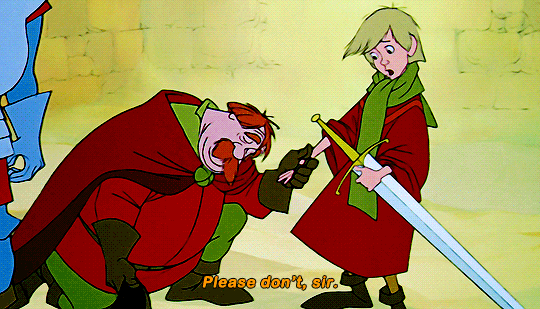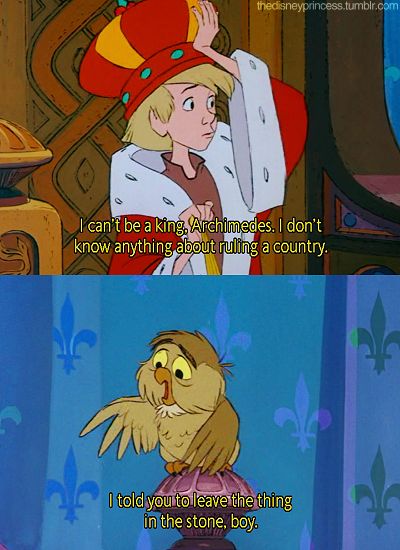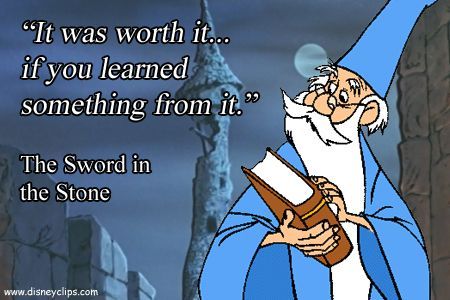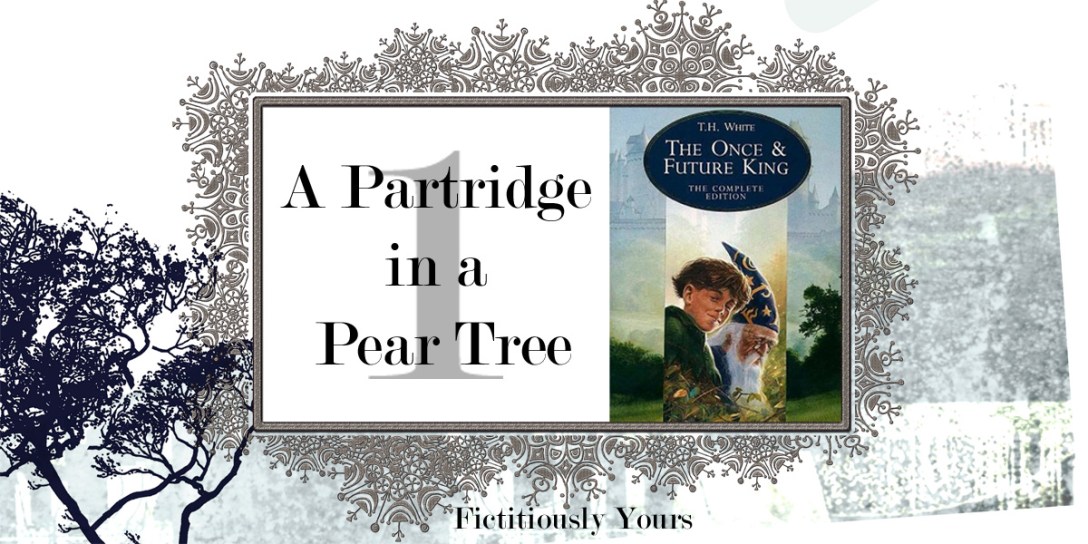Though one of the first of the modern fantasy novels, T.H. White’s creations of modern Arthurian myth seem to have been relegated to mere “children’s literature” in a way that even C.S. Lewis’ Chronicles of Narnia haven’t been. Which designation, aside from being patently inaccurate, does an injustice to the depth and complexity of White’s reimagining of Malory’s Le Morte d’Arthur, along with his significant innovations. White adds character developments throughout his five parts that serve to rationalize a lot of the more confusing (and troubling) actions and elements of the Malory version. Of course, as a prominent consideration, this book is directly derivative of Le Morte d’Arthur, which is from the French tradition and as such portrays certain characters in wildly different lights than other traditions, Gawain being one of them. And sometimes White outright fabricates personalities where none were to be had in the Malory book.
Merlin living his life backward, explaining at once his knowledge of the future and his difficulty remembering which points of this type of “prophecy” should be given to which people at which times, is a fascinating element that as far as I know is unique to White’s legend. It also allows for complete liberty introducing anachronisms and modern parallels to a pseudo-medieval story, which is at times as pointed as it is hilarious. If you ever needed communism, fascism, and democracy explained in relation to Camelot, this is where you find it. It is also, undeniably, a bit of a roller coaster. But it is full of fun and the nods to twentieth century culture and events give it a completely unique tone from anything else I have read.
The Sword in the Stone
The essential introduction to young Wart and his chaotic lessons in animal life with his tutor Merlyn, in preparation for his recognition as rightful king. Not unlike the whimsical Disney animation, this first instalment of the myth is a rather episodic children’s tale as Wart spends time as a fish, fowl, and furry creature to learn the different ways of life. This is the story in which we are introduced to King Palomides and the Questing Beast, as well as Robin Hood, who rather anachronistically appears, and Wart performs the titular feat by removing the sword from the stone. It is sufficiently optimistic and childlike, the better to contrast with the next story of the younger days of famous knights of Camelot.

The Witch in the Wood
Beginning with a grim portrait of the life at the castle of Orkney, with mother Morgause and sons Gawain, Gaheris, Gareth, and Agravaine, The Witch in the Wood, also called The Queen of Air and Darkness, is a drastic leap in tone. Orkney in White’s mythology is a Gaelic land steeped in dark magic and superstition unlike that of Arthur’s boyhood. Gawain and his brothers grow up under the alternately negligent and abusive care of a powerful sorceress, twisting their love for her into something bordering on Freudian, in the case of Agravaine particularly. The Questing Beast and its comical pursuers return, but mostly serve as a contrast with the more grisly and horrific account of the four young brothers’ pursuit of a magical unicorn. The relatively short book closes with Gawain and his mother’s visit to Camelot and audience with the young King Arthur, an atmosphere of inescapable doom immediately preceding the incestuous conception of Mordred.

The Ill-Made Knight
Lancelot’s early training, boyhood worship of Arthur, and rise to fame as a prime knight of Camelot are only the beginning of this episode in the saga. The Ill-Made Knight spans at time of over twenty years as Lancelot falls in love with Queen Guenevere, overcomes his passions successfully for a time, and then falls back into them as a final nail in Camelot’s coffin. Meanwhile, Arthur has established the rule of chivalry and is slowly conquering his way to a more equitable future for the land he governs, but not without self-doubt and mistakes along the way. Surprisingly, I did not hate this book, although Lancelot is far from my favourite character. White did an admirable job building his character in such a way that he was not only understandable but sympathetic. Guenevere too is a very interesting and dynamic personality much more than just the flimsy floozy she can be portrayed as. Using Lancelot’s exploits as a vehicle to deliver many important events, not all of which are directly focused on Lancelot, White also manages to sidestep the majority of Sir Tristan’s dreary love story that dragged down so much of Malory’s book. I cannot thank him enough for that. There is genuine spiritual turmoil in Lancelot’s journey that makes The Ill-Made Knight one of the most religious of the books, due in part to the grail quest, and highlights a lot of incongruities and conflicts between the various worldviews vying for pre-eminence in this land on the cusp of catastrophe.

The Candle in the Wind
In which it all collapses. If you are unfamiliar with the complete and utter domino chain of disaster that precipitates Camelot’s fall and the death of Arthur, I can only recommend that you brace yourself for many “No, you idiot!” moments. One might be tempted to say, “No, you idiot!” when Mordred insists on outing Lancelot and Guenevere as a couple despite its impact on the kingdom. You might think of saying it when Arthur privileges Gawain’s thirst for revenge instead of making an executive decision to not plunge his country into civil war over a misfortune. It might come to mind as a suitable exclamation when Arthur opts to put freaking Mordred in charge of the country in his absence, while off to besiege Lancelot’s domains in France with half his military force. Any one of these occasions would be warranted. But The Candle in the Wind doesn’t present it that way, of course. It’s a melancholy, sombre dirge for the lost glory of a country and way of life that might-have-been. In a sense, Camelot was such that it could not have gone on, and that these were incidents that finally toppled it is no more than chance of events and personalities.

The Book of Merlyn
An addendum to the original myth, and to White’s publications, The Book of Merlyn details a convocation of Merlyn with the various types of creatures Arthur had spent time learning from. It is in a sense a return to that slightly disjointed narrative of The Sword in the Stone that is more thought-experiment than story. In their discussion of various forms of government, at times as thought-provoking as it is ridiculous, these noble (and not-so-noble) creatures appear to see a way through the conundrum of doom that set upon Arthur’s reign from its inception. A supposedly “happy” ending to what Malory left quite bleak and futureless, this book emphasizes the expectation of Arthur’s return at a time more well-suited to his visionary leadership and leaves the reader with a hopeful feeling.


I loved these books as a child, and your review makes me think I should definitely reread them.
LikeLiked by 1 person
I wish I had read them when I was younger too, but there’s also so much to appreciate about good children’s literature when you’re older too!
LikeLike